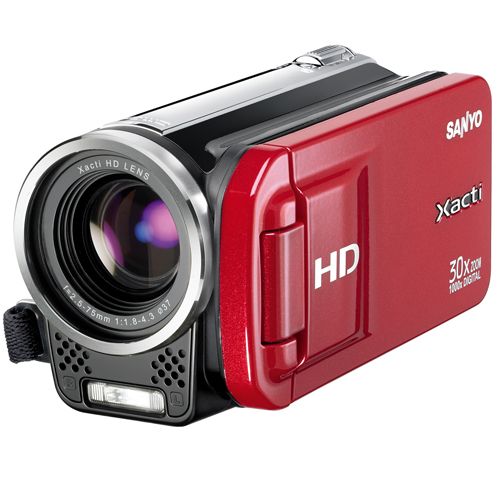The TH1 is aimed at those on a budget who still want to benefit from HD recording. It’s 720p rather than Full HD, but that’s still more than adequate for most applications.
Our quick take
There are some advantages over the lower end recorders such as the 30x zoom and large, bright LCD screen, but the end product doesn’t differ massively. If you can afford the extra go for a Full HD and model you’ll be much happier with the results; as for the still performance don’t even bother.
If the Sanyo was positioned as a video camera alone it would have recorded an average score; not bad, but not great. However, you’re supposed to be able to use the TH1 as a stills camera too and in this respect the quality just isn’t good enough.

Sanyo Xacti VPC-TH1 camcorder - 2.5 / 5
| FOR | AGAINST |
|---|---|
|
|
The 3in widescreen LCD screen is impressive as is the 30x optical zoom. The TH1 uses SD or SDHC cards though it does have an internal memory capacity of about 40MB, which should be enough in an emergency, for images at least. That internal storage will give you 38 seconds, 57 seconds and 1:49 in the three video modes.
The top resolution of 1280 x 720 pixels at 30 frames per second isn’t bad, however the only other resolution available is a 640 x 480 option at 30 or 60 frames per second. You can capture still images at 1600 x 1200 pixels, which makes this a rather unimpressive 2-megapixel camera. Sanyo bill the TH1 as a dual camera, suitable for both video and still photography, but with just 2 million pixels you’ll probably want a regular stills camera too.
The short body of the Sanyo might not appeal to everyone, but it’s not too bad to use. At first we found the button placement a bit odd, however, over time it became less of an issue. The menus are a simple affair, however, you can put the camera into super simple mode if you so wish.
The Sanyo has a mini sized HDMI connection for you to hook-up directly to an HD TV or amp though the cable isn’t supplied with the camera. The supplied cables will allow you to connect to a TV with a Composite connection.
Rarely does a camera do so badly that we’d warn against using it, but sadly the idea that you might be able to use the TH1 as a stills camera as well as a camcorder is a poor claim. The stills shot with the Sanyo are terrible. Five years ago we’d have been disappointed with quality like this: today it is inexcusable. Rather than suggest you can use this as two cameras in one, Sanyo should have left off the photo function altogether.
Video was better than the still performance, but to be honest that wouldn’t be difficult. Here the Sanyo provides much more acceptable results, but they are only that, nothing more. Video was a touch soft and colours ok, but we’ve seen similar performance from cheaper camcorders.
This is essentially a stripped down version of the Xacti VPC-FH1, which offers more options and Full HD recording. Importantly the VPC-FH1 has a 1cm CMOS chip wile this model has to do with a 0.4cm version. If you’re not bothered about the true HD capture or can cope with a smaller range of features then the TH1 is certainly a nice camera to use. However, the real problem for the TH1 is that it sits uncomfortably in the middle of a range, neither one thing nor the other.
It’s more expensive than the Flip Mino HD and Kodak Zi6 yet cheaper than its full HD brother the FH-1. It doesn’t offer a massive step up in video quality from the budget models and isn’t close to the quality of the full HD version.
To recap
The TH1 just doesn’t offer the quality we’d expect from a camera of this type, stills are terrible and video is only ok
